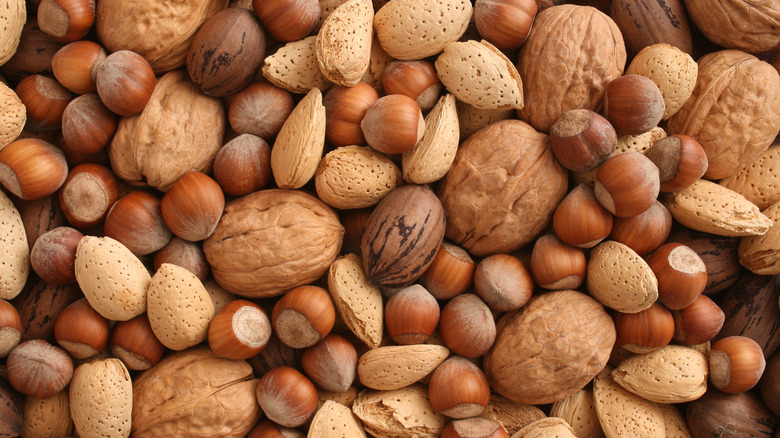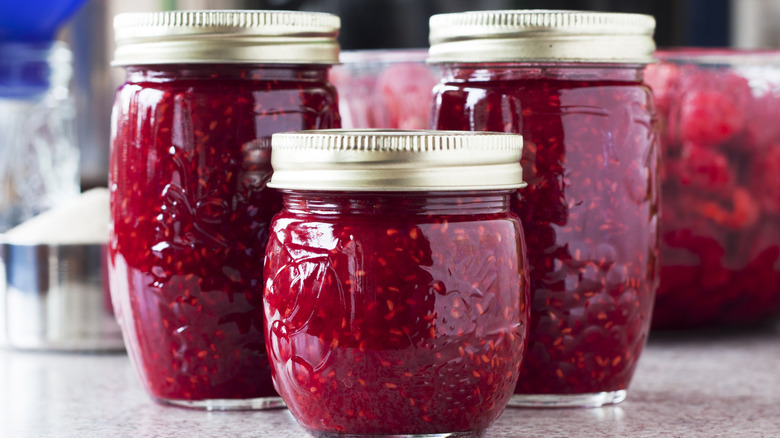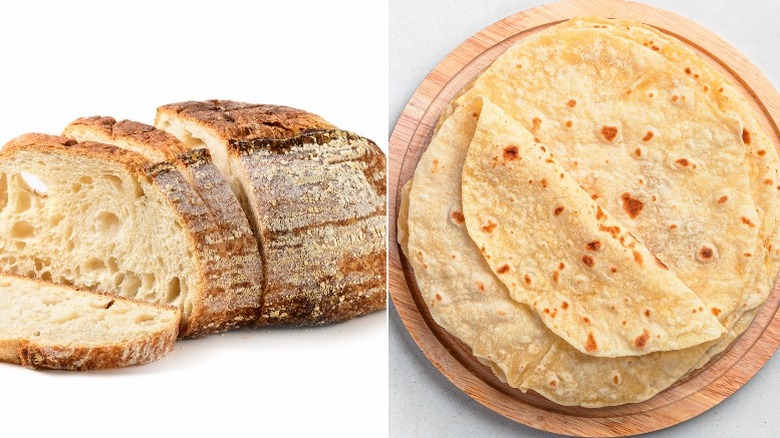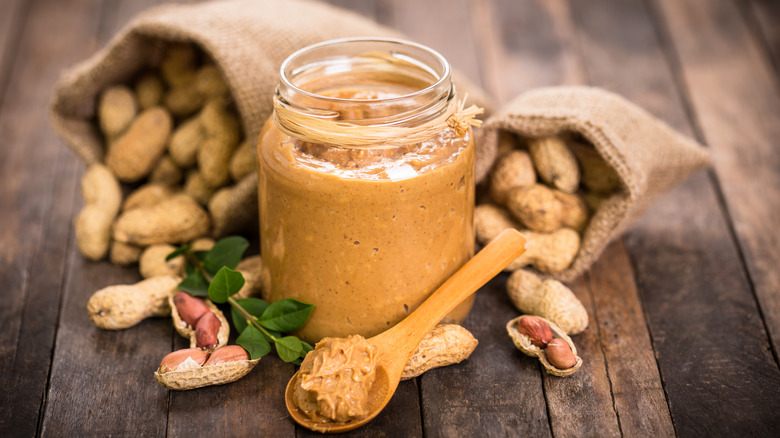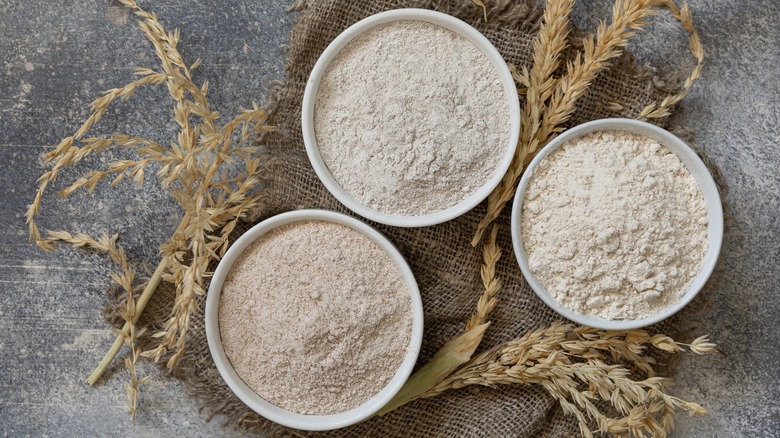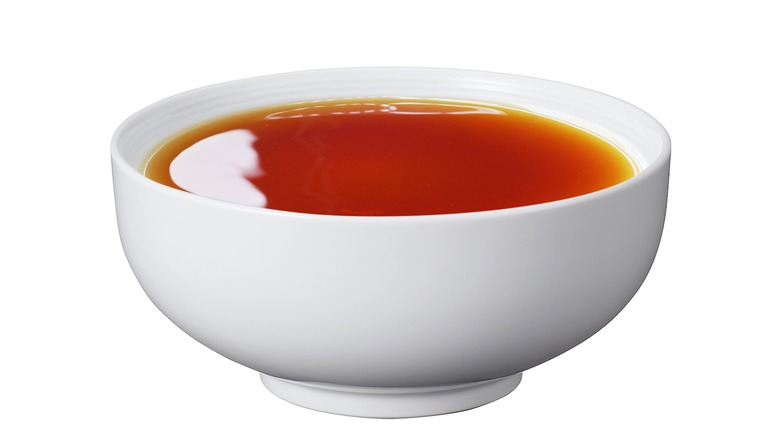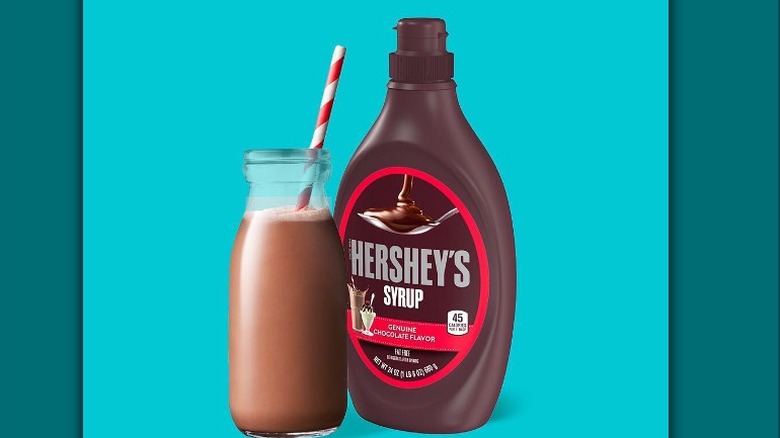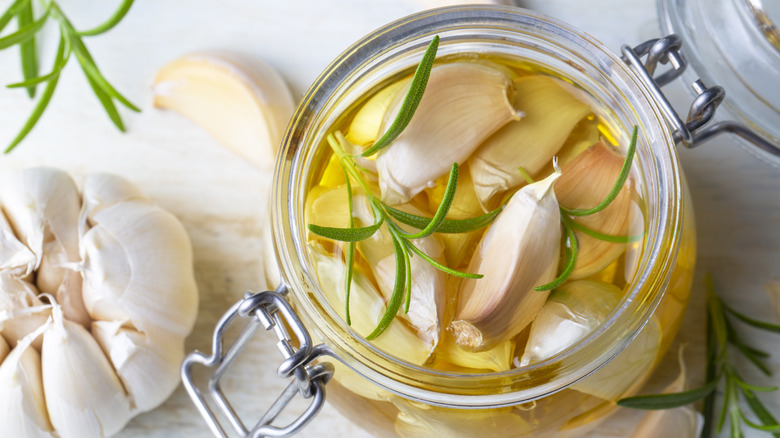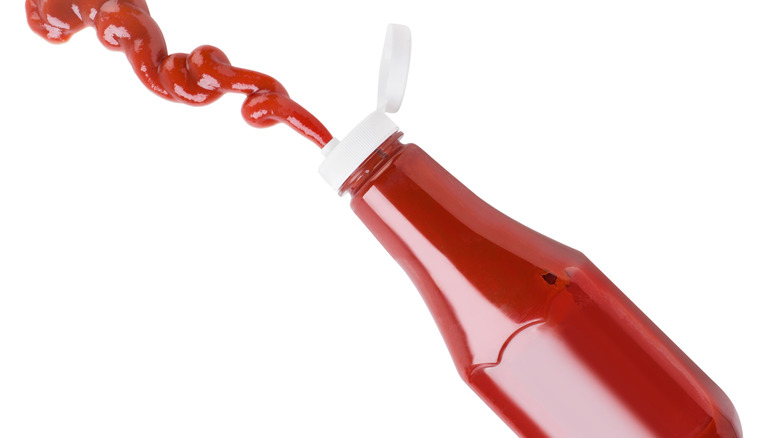14 Foods You Should Stop Storing In Your Pantry
If you're not careful, your pantry can quickly turn into a dumping ground for years-old cans of lima beans, packets of gluten-free pasta, and off-brand tuna. As the months pass, these less-than-desirable items get shoved farther and farther into the deepest recesses of your shelves, only to resurface when you take on a massive spring cleaning or move. Fortunately, most of these items can survive for years in the depths of your pantry without spoiling. Many will even retain their freshness and flavor for a half-decade or more.
Although some pantry items are designed to survive an apocalypse, not every food belongs in your spillover storage space. In fact, many foods lose flavor, dry out, or grow mold when stored in the pantry. Some items, like fresh fruits and vegetables, are obvious pantry no-gos. But there are plenty of other items you might be storing in your pantry that don't belong there. In this article, we discuss some of these oft-misplaced items and explain why they're better suited for the fridge or freezer.
1. Nuts and seeds
At first glance, nuts and seeds seem like obvious pantry items. After all, they're usually packaged in resealable sachets, metal tins, or plastic containers. Given the integrity of their packaging, it seems like keeping out light, moisture, and air would be a cinch. That's not entirely false, but it's important to keep in mind that nut containers aren't without their faults. The main issue is that packaging doesn't protect nuts and seeds from temperature changes. Warm temperatures are particularly harmful because they cause the naturally-occurring fats to oxidize, leading nuts and seeds to go rancid over time.
Storing nuts and seeds in cooler temperatures slows down the oxidation process, meaning nuts and seeds last much longer. As an example, almonds have about a nine-month shelf life in the pantry, a one-year shelf life in the fridge, and a remarkable two-year shelf life in the freezer. The first step to freezing nuts is to put them into an airtight container (either a freezer bag or a plastic tub). Write the freezing date on the outside. When you're ready to use the nuts, allow them to come to room temperature before opening the container. This way they won't absorb extra moisture and become soft.
2. Maple syrup
If you're one of those heathens who only eats fake maple syrup, then go right ahead and skip this section. These corn syrup-laden abominations contain preservatives like sodium benzoate and potassium sorbate, meaning you can store open bottles in the pantry for up to a year. The same can't be said for pure maple syrup, which contains just one ingredient — boiled maple tree sap. Before we explain why you need to store pure maple syrup in the refrigerator, it's worth pointing out that unopened maple syrup will keep for up to one year in the pantry. Maple syrup is heat-packed during the bottling process, something that keeps the syrup free from contamination.
Once the syrup is exposed to air, that protection is gone. At that point, you should move the bottle from the pantry to the fridge. Fail to do so and before long you'll notice yellow-gray mold floating on the surface. You can scrape the mold off and boil the maple to restore its flavor, but why make extra work for yourself if you don't have to? While refrigerating is the most common storage method, freezing pure maple syrup extends its shelf life almost indefinitely. Not only does the high sugar content prevent the syrup from freezing, but you can thaw and refreeze as many times as you want without sacrificing taste.
3. Mustard
Compared to other foods on this list, mustard won't suffer too much if stored in the pantry. That's especially true of yellow mustard. In fact, French's, the undeniable king of yellow mustard, states that its products can be stored at room temperature. The company goes on to say that its mustard contains zero ingredients that will spoil in the pantry. However, French's admits that its Dijon and horseradish-based mustards are better kept in the fridge. These more pungent varieties will lose some of their flavor if stored in the pantry.
Gulden's, another mustard kingpin, doesn't provide as many details as its competitor, but its product pages do suggest refrigerating after opening. This applies not only to its Stone Ground Dijon and Spicy Brown varieties but also to its yellow mustard. Mustard kept in the refrigerator won't go bad, per se, but it will become less tasty as time goes by. The exact best-by dates differ, but in general, refrigerated Dijon and yellow mustards will last about a year, while honey mustard could last up to two years.
4. Jam or jelly
Whether we're slathering some on our morning toast or mixing a spoonful into our afternoon yogurt snack, jam is one of those kitchen staples we like to keep within arm's reach. It's tasty, versatile, and makes whatever we're biting into taste a thousand percent better. Still, for as much as we love our jams and jellies, they're not items we'll be storing in the pantry any time soon.
Sure, their high sugar content and acidity provide a layer of protection from spoilage, but this shield doesn't last forever. Opened jams and jellies keep for about a week when stored in a dark environment at room temperature. After this brief probationary period, microorganisms colonize, leading to mold or yeast growth. At hotter temperatures, fruit spreads separate and turn rancid in the span of days. Refrigerating your favorite jam or jelly preserves its flavor and discourages mold growth, two things that extend its shelf life. Speaking of shelf life, jams and jellies last for about six months after opening in the refrigerator.
5. Bread and tortillas
If you're anything like us, you've always stored bread and tortillas in the pantry or on the counter. Probably everyone you know does the same. Peer pressure aside, most supermarket brands are full of preservatives like sodium benzoate and sorbic acid, that prevent bread from going bad. These additives do extend the shelf life, but they're not perfect. Without enough moisture, the starch molecules found in bread align themselves like soldiers ready for battle, creating a crystalline structure that's tough to bite into.
The antidote is storing bread in a somewhat moist environment. At first glance, the refrigerator might seem like an obvious choice, but storing your bread or tortillas at low temperatures causes them to go stale even more quickly. In cold temperatures, starch molecules still have a chance to crystallize. Freezing is the counterintuitive solution. Freezing temperatures stall mold growth and staling. The best way to prepare bread for freezing is to wrap it in plastic wrap, slide it into an airtight freezer bag, and write the freezing date. Store for up to six months.
6. Organic nut butters
Processed nut butters like Jif or Skippy peanut butter are well-suited to the pantry. They contain a lot of fat and not much moisture, two features that stave off bacteria. Many typical supermarket nut butter brands also contain stabilizers such as hydrogenated oils that further discourage spoilage. What's more, some brands add preservatives like sodium benzoate to extend the shelf life. An opened container of processed nut butter will last two to three months in a cool, dry pantry. After that period, stick it in the fridge to squeak out another three or four months of freshness.
When it comes to natural or organic nut butters, it's a different story. These varieties typically contain only ground nuts and salt. Without any preservatives, the oils in the nuts can turn rancid, transforming your delicious breakfast spread into an unpalatable nightmare. This process takes a month or more, so if you plan on eating the whole jar within that time frame, it's fine to store it in the pantry. Beyond a month, play it safe and store natural nut butter in the refrigerator. Stirring cold nut butter takes some extra elbow grease, but it's worth the extra months of shelf life you earn.
7. Cold-pressed oils
There are about as many oil-making processes as there are types of oil. To the uninitiated, keeping track of the difference between extracted, pressed, and cold-pressed oils is more than enough to cause a headache. We won't go into the details here, but it's enough to know that cold-pressed oils are some of the healthiest on the market. Unlike other oil-extraction methods that involve chemicals, bleaching, and high temperatures, cold-pressing is a natural process that helps oils retain as many heart-healthy antioxidants as possible. Oils obtained through cold pressing are also free of chemicals, making them one of the purest varieties available.
While the health benefits of cold-pressed oils are undeniable, they spoil quickly if exposed to excessive light and heat. At worst, this means color change and mold growth; at best, it means a weaker aroma and flavor. For these reasons, we recommend storing your cold-pressed oils in the refrigerator. Note that the cold temperatures may cause the oils to solidify or turn cloudy. This is no cause for concern. Simply leave the bottle out of the refrigerator for a couple of hours before using it. Alternatively, you can speed up the process by placing the bottle in a pot of warm water.
8. Whole-grain flour
Flour is one of those ingredients that's really easy to buy, stick in the back of your pantry, and forget about until it's time to make cookies for the school bake sale. Unfortunately, contrary to popular belief, flour can and does go bad. When flour is exposed to moisture, heat, light, or oxygen, the naturally-occurring oils in the bran, endosperm, and germ go rancid. Pest infestations (particularly weevils) also cause flour to go bad before its best-by date. Storing flour in an airtight ceramic or stoneware container does a lot to protect it, but it's not a panacea.
The best way to protect your flour (especially the whole-wheat variety) is to store it in the refrigerator or the freezer. Colder temperatures do double duty. Not only do they keep flour away from heat and moisture, but they also slow down the aging process. To shield your flour from light, make sure to store it as far away from the refrigerator or freezer door as possible. In addition, you should pack flour in an airtight container or a sealable plastic bag (just make sure to remove the air before storing it). Whole-grain flour keeps for six months in the refrigerator or one year in the freezer. One final tip: allow the flour to come to room temperature before baking with it or it won't rise.
9. Cured meats
In broad terms, curing refers to the process of using salt to preserve meat. Some popular types include pepperoni, prosciutto, and chorizo. Although there are different curing techniques, the general principle is that salt draws moisture out of the meat and takes harmful bacteria with it. This process preserves the appearance, flavor, and longevity of the meat. But just because cured meats last longer than their raw counterparts doesn't mean they should be stored in the pantry.
During the curing process, meat is kept between 50 and 60 degrees Fahrenheit to prevent bacteria growth. Anything above 60 degrees is a breeding ground for lactic acid bacteria. While not particularly harmful to consume, these bacteria produce acids that ruin the flavor of your beloved speck or coppa. For that reason, it's essential to store cured meats in the refrigerator. Wrap them tightly in plastic wrap before storing and do your best to keep them away from light. Thinly sliced cured meats (like prosciutto) last about three days in the refrigerator, while harder varieties can last up to two weeks.
10. Fish sauce
Whether you choose to drizzle it over a steaming bowl of ramen or serve some alongside Vietnamese lemongrass meatballs, fish sauce adds salty, savory, umami notes to whichever dish you add it to. Many home chefs choose to store it in the pantry alongside other staple liquids like soy sauce and sesame oil. You can get away with it, but it's not ideal. Just a quick look at the ingredients list is enough to tell you why.
In addition to water, salt, and a sweetener (typically caramel or molasses), fish sauce is made with fermenting fish. Anchovies are one of the most commonly used types of fish, but shrimp, krill, and mackerel-based sauces are also available. The fermentation process won't make you sick, but it is smelly. Storing fish sauce in a warm pantry environment can make the smell even stronger. Warm temperatures cause gas to accumulate in the bottle. Once you open it, the odor has the potential to permeate other food items, giving them an unwanted fishy smell. Aside from preventing a potential stink bomb, storing fish sauce in the refrigerator keeps it fresher for longer. Case in point? Fish sauce stored in the pantry lasts three to six months, while sauce stored in the refrigerator is good for up to a year.
11. Chocolate syrup
Chocolate milk, crepes, or an ice cream sundae — there's no end to the uses for chocolate syrup. But before you accessorize your next dessert, take a minute to think about where you've been storing your chocolate syrup. It's perfectly fine to store an unopened bottle in the cupboard. In fact, an unopened bottle can last for at least a year in a cool, dark pantry. But once you pop the top, make sure to refrigerate it.
Commercially-made chocolate syrup lasts for about a year in the refrigerator. If you're lucky, the shelf life could be longer, but past a year, you should look out for signs of spoilage. Lack of flavor, a funky smell or appearance, and texture changes (separation or clumping) are some of the most common clues to look out for. In some rare cases, chocolate syrup can become moldy, however, the high sugar content usually prevents that from happening.
12. Infused olive oil
Olive oil is great on its own, but something about adding fresh herbs, spices, and aromatics turns regular EVOO into a centerpiece-worthy creation. But infused olive oil doesn't rely on its good looks to get by. It does some serious culinary heavy lifting as a salad dressing base, a sauce for grilled veggies, or as a soup drizzle. The uses are truly endless, but alas, there's one major downside to infused olive oil — it's liable to make you very sick if you store it in the pantry.
Infused oils, especially those containing fresh ingredients, could contain botulism spores as a result of contaminated soil. According to the Centers for Disease Control and Prevention, botulism is caused by the Clostridium botulinum, Clostridium butyricum, and the Clostridium baratii bacteria. Any one of these bacteria can cause botulism, a rare but serious illness that targets the nerves. It can cause breathing problems, muscle paralysis, and even death. Refrigerating infused olive oil slows down bacteria growth, thereby minimizing your risk of illness. Still, you shouldn't keep them for longer than a month, just to be on the safe side.
13. Ketchup
There are a lot of food debates going on. Like should you fold your pizza in half or eat it flat? Is a hot dog a sandwich? Do you cut your sandwiches in half or diagonally? But more than any food debate we've encountered, the discussion about where to store ketchup is a heated one. On one hand, you've got the pantry fans. They claim that there's simply no room in the refrigerator for a sauce that restaurants keep at room temperature all the time. The refrigerator camp doesn't have an argument so much as an assertion that ketchup should be chilled.
Both sides are valid. And it's true that ketchup's high acidity (thanks to the vinegar and tomatoes) makes it safe to eat regardless of the storage temperature. Still, it's better to keep it chilled, if only to prolong the shelf life. Pantry ketchup is best eaten within a couple of weeks, whereas chilled ketchup lasts up to two months.
14. Chocolate
Chocolate is another one of those foods that inspires debate, particularly when it comes to where to store it. Those in favor of pantry storage claim that refrigerators change the structure of chocolate. More specifically, chocolate that goes from room temperature to cold condenses. This process causes a grainy white residue to form on the surface. This is mostly an aesthetic problem but might be unappealing to some. Looks aside, chocolate stored in the refrigerator may absorb the flavors of other foods thanks to its porous nature.
Those in favor of chilling it recommend storing it in the freezer. While the risk of odor absorption is still there, freezing can prolong chocolate's shelf life. Start by breaking the chocolate into small pieces to prepare it for the freezer. This will make getting the desired quantity much easier post-freezing. Next, wrap the chocolate in plastic wrap, then place it in a freezer bag. Remove as much air as possible. Write the freezing date on the bag and consume within a year.
Static Media owns and operates Tasting Table and Mashed.

